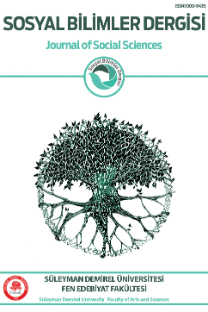Birbirleri ile Konuşan Makinalar: Bilginin Açık Veri Destekli Açık Erişime Doğru Evrilmesi
Çalışma ile, açık bilim ekosistemine dayalı olarak dijital formlu bilimsel bilgi nesnelerinin makineler aracılığı ile işleyiş algoritmaları ele alınmıştır. Bu algoritma temel işleyiş mantığının nasıl, hangi protokollerde, yazılım ve standartlarda işleyişi etkileştiği yapılar açık bilim/açık erişim ekosistemi içerisinde literatür destekli olarak ele alınarak, yakın gelecekteki değişim öngörüleri sonuç bulguları ile birlikte ortaya konmuştur. Çalışma ile, bilgi nesneleri; dijital formları, içerikleri, etkileştiği yapı ve sistemleri “Açık Bilim / Açık Erişim” ekosistemi içerisinde değerlendirilmiştir. Çalışmada betimleme yöntemi kullanılmıştır. Bu kapsamda; dijital bilgi nesnelerin varoluş nedenleri, etkileştiği yapı ve sistemlerin neler olduğu, nasıl etkileştikleri ortak bileşenleri ile birlikte literatür destekli olarak açıklanmaya çalışılmıştır. Araştırma bulguları; çalışmanın sonucunda gözlemlenen ve elde edilen verilere göre bilimsel gerçekliğin kanıtları olan literatür destekli özgün “sonuç” ve “öneri” olarak 6 madde de toplanarak çalışmanın sonucunda belirtilmiştir. Çalışmanın sonuç ve öneriler bölümü çalışmanın içeriğini kapsayan bütünsel yapının tamamından oluşmaktadır. Bulgular ile araştırma konusunun güncelliği ve önemi; gelişen bilgi teknolojileri, yapay zekâ yazılımları, açık bilim ve açık erişim platformları ve dijitalleşen bilgi nesnelerinin bu bileşenlerde etkileştiği yapı ve sistemler içerisinde kendi aralarında nasıl konuştukları, bilgi alış verişinde bulundukları ve yapısallığın bilgi, bilgi merkezleri ve bilgi kullanıcıları açısından önemi vurgulanmıştır. Bu çalışma, dünyada gelişmekte olan dijital formlu bilgi nesnelerinin OAI-PMH- AI-GPT yapay zekâ alt yapı platformlarında bilgisayar/ağ destekli yapıda hibrit ve otonom haberleşmeleri, kendi aralarında bilgi alışverişi sağlamalarını içeren özgün bir değerlendirme çalışmasıdır.
Anahtar Kelimeler:
Açık Bilim, Açık Veri, Bilgi Teknolojileri (BT), Açık Erişim, Yapay Zeka (AI), Ağda Konuşan Makinalar
Machines Talking to Each Other: The Evolution of Information Towards the Open Data Supported Open Access
In the study, the algorithms of operation of digital formed scientific information objects through machines, based on the open science ecosystem, are discussed. How the basic working logic of this algorithm is and which protocols, software and standards it operates and interacts with are discussed with the support of literature within the open science/open access ecosystem, and the predictions of change in the near future are presented together with the final findings. By study, knowledge objects, digital forms, contents, interacting structures and systems were evaluated within the “Open Science / Open Access” ecosystem. The descriptive method was used in the study. In this context, the reasons for the existence of digital information objects, the structures and systems they interact with, and how they interact, together with their common components, have been tried to be explained with the support of the literature. The research findings are stated at the end of the study by gathering under 6 items as the original "result" and "suggestion" supported by the literature, which are evidence of scientific reality, according to the data observed and obtained at the end of the study. The conclusion and suggestion section of the study consists of the entire structure that covers the content of the study. With the findings, the topicality and importance of the research topic, how developing information technologies, artificial intelligence software, open science and open access platforms and digitalized information objects communicate and exchange information among themselves within the structures and systems in which these components interact, the importance of structuralism for information, information centers and information users were emphasized. This study is an original evaluation study that includes hybrid and autonomous communications and information exchange among themselves in computer/network supported structure on OAI-PMH-AI-GPT artificial intelligence infrastructure platforms of the developing digital information objects in the world.
Keywords:
Open Science, Open Data, Information Technology (IT), Open Access, Artificial Intelligence (AI), Network Talking Machines,
___
- kaynakça eklenmeli
- ISSN: 1300-9435
- Yayın Aralığı: Yılda 3 Sayı
- Başlangıç: 1995
- Yayıncı: Süleyman Demirel Üniversitesi, Fen-Edebiyat Fakültesi
Sayıdaki Diğer Makaleler
Bourdieu Kavramlarıyla Askeri Alanı Okumak
İran'ın Kültürel Bir Antitezi: Turan
Filiz TEKER, Muhammet Beşir AŞAN
Yaşam Kalitesi ve Sosyal Sermaye Unsuru Olarak Güven ve Kurum İlişkisi
Yaşlı Bireylerin Dijital Alanda Sosyalleşmesi Üzerine Bir Çalışma
Meyrem TUNA UYSAL, Şermin ZENGİN
Kiğı Sancağı’ndaki Aşiret ve Cemaatlerin Sosyo-Ekonomik Yapısı (1518-1642)
Yol ve Töre Dergilerindeki Yazıları Ekseninde Erol Güngör’ün Türk Soluna Yönelik Eleştirileri
Hazarlarda Hiyerarşik Düalite: İkili Krallık Sisteminin Tarihsel Kökenleri
Birbirleri ile Konuşan Makinalar: Bilginin Açık Veri Destekli Açık Erişime Doğru Evrilmesi
